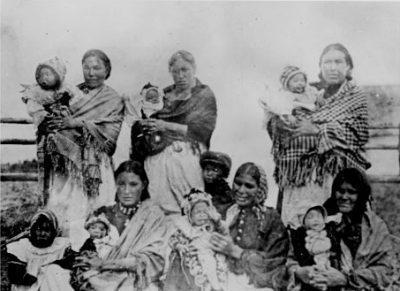Ethnographic accounts of Chipewyan dependence on caribou suggest potential seasonal change in the nutrition of caribou and hunter. As human seasonal nutrition depends on herd seasonal nutrition, to maximize weight and the ratio of fat to meat, cows and bulls were preferred in different seasons. Bulls were best in summer and early fall, but November rutting consumed back fat and tainted meat. Cows were better in late fall and mid-winter, while smaller, non-pregnant cows and yearlings had fat that lasted until spring. Fat is crucial to diet and especially for human conception, but was available mainly in summer and autumn. Seasonally, the Chipewyan diet was balanced by eating everything edible. In summer, fall and winter, meat provided protein, fat, iron, vitamin A, riboflavin and niacin. The heart, liver and kidneys gave vitamin C and thiamine. Blood was rich in protein and iron; intestine and stomach contents added calcium, carbohydrates and fiber. Back fat gave vitamins A, E and K, while soft bone ends gave calcium and phosphorous, and the eyes, vitamin A. Seasonally available fish, birds, berries, muskox, beaver and bear supplemented diet, but had limited effect on annual nutrition.
Nutrition peaked in July-August when caribou were killed by the hundreds. Meat was eaten raw, dried in strips, or powdered with fat and berries to make pemmican, a convenient, light, nutritious trail food that gave energy for herd-following. When the herd scattered in the winter forest, pemmican became depleted and malnutrition increased. By early spring, people were starving because fish, bear, beaver and birds were few, thin or unavailable. At this time weight loss caused mainly by fat absence stresses lactating mothers (Frisch 1988) and lowered fertility among the Chipewyan.
Birth spacing in most hunting, fishing, gathering and pastoral peoples relate more to female nutrition than cultural factors like birth control, spousal separation and frequency of intercourse (Rosetta 1992:83). Fertility decreases in chronic malnutrition in proportion to food deprivation. Even short term malnutrition impairs ovarian function, disrupts menstruation and lowers the fertile lifespan. A turn-of-century north Greenland study showed Polar Inuit women did not menstruate over a 4-month winter period (Cook 1894a, 1894b, 1897). In addition, very few cyclic menses occurred among 1950-60’s breast-feeding Inuit (Otto Schaefer, pers. comm. to Condon). The link between nutrition and fertility results in later Chipewyan puberty, earlier menopause and fewer children. Women lactated for 3-4 years, rarely having more than five children in 20 reproductive years (Mason, in Jenness 1955; Hearne, in Glover ed. 1958:201). Chipewyan seasonal nutrition determined both health and fertility.
To test fertility and birth spacing among herd followers, hundreds of 19th and early 20th century Roman Catholic baptisms showing Chipewyan birth dates in the Beverly and Kaminuriak winter ranges were scanned by computer. They indicate 4 of 5 babies were born in February, March and April, with an April peak (Sister Rose Arsenault, pers. comm.). A very steep conception peak occurred in July-August on the tundra when fat from hundreds of caribou was plentiful, with births in the northern forest nine months later. By late summer, mothers moved north again, carrying their infants in their parkas. Although herd-following by these Chipewyan never attained the magnitude taken by their ancestors, most hunted close to the big mid-route sites where past harvesting intensified. Their mothers and grandmothers obviously had also been subject to summer food peaks and spring deficits causing birth spacing. Their cycle of July-August conception and March-April birthing meshes well with the caribou cycle, just as it undoubtedly did for earlier peoples. As meat and fat are critical to human reproduction, seasonal camp locations offer clues to the reproductive state of Chipewyan women.
Children joined their parents in long treks across the Beverly range. Few adults went the length of the range. Rather, hunting families in northern Saskatchewan went to treeline, while groups just south of treeline in the Northwest Territories went to the calving ground. In late summer, both groups congregated at treeline sites as they prepared for winter in the forest. It is very difficult to find evidence of children in their ancient camp, but half-year-old babies were carried beyond the treeline, while capable children walked these distances. Hearne (1958: 201) reported that it was rare to see a woman with more than 5-6 children because spacing was 2-3 years due to suppression of fertility and nutritional deficits caused by breast feeding of children to ages 3-4. Due to the nature of herd migration and following, human conception and birth seasonality were alike in all Beverly people. Pregnancies were most likely to occur during the maximum nutrition of extensive harvesting of summer migration. Children were least likely to be conceived at times of chronic malnutrition in late winter. Ethnographically and historically, the Chipewyan had most babies in late winter around Black and Athabasca Lakes. Ancient peoples likely were similar, and during herd following, may even have carried their 3-4 month old babies north towards the treeline in moss bags like the Chipewyan. As human conception occurred during late summer band aggregation at the major Thelon and Dubawnt water-crossings, I suggest young men and women from different sub-bands met and coupled there rather than during winter activities that were traditional in many northern societies.

Chipewyan babies born about February to April. Baby in foreground is in a moss bag.
Fr. P. Duchaussois. Reprinted with permission of Oblate Archives, Yellowknife.
| from Gordon 1996. People of Sunlight; People of Starlight: Barrenland Archaeology in the Northwest Territories of Canada.Archaeological Survey of Canada, Mercury Series Paper 154. Canadian Museum of Civilization, pp.15-16; 245-246. |